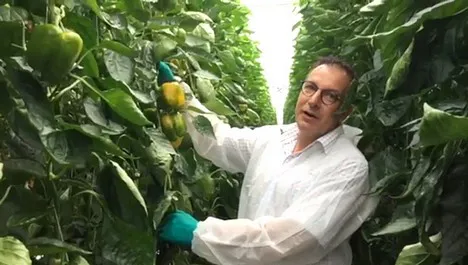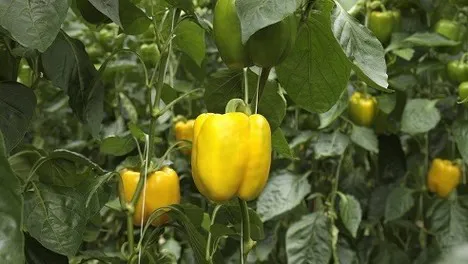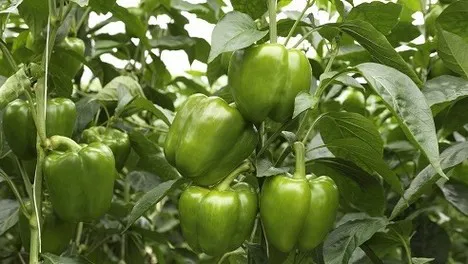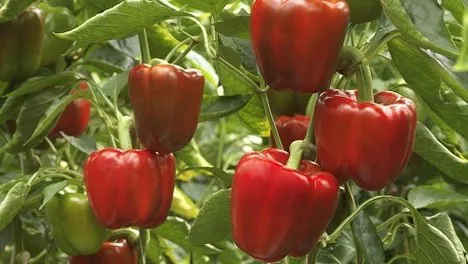COVID-19 may not be harmful to plants, but the effects of the virus are still notable in horticulture. Crop advisors only visit companies if it is really necessary, says Peter Colbers with Syngenta. With contactless visits and digital solutions, they are still able to support growers. "I admire how growers cooperate in sharing information", says Peter.
Now the days are sunny and bright, yet in the Netherlands the month February of this year was very dark, and the nights in March were cold. This made for a challenging start of bell pepper season, and the fact that the advisors with Syngenta can't visit the greenhouses, doesn't make it any easier. Especially because some fine new varieties are out there, which could make the difference, particularly in the second half of the season, says Peter.

New varieties
Syngenta launched three new varieties this year, in yellow, red and green, and they were surprisingly well introduced: there's about 15 hectares of all three of them. "The trend in pepper is big, bigger, biggest. Especially in yellow bell pepper, people say it needs to be course, especially in summer.
With our new yellow variety, we have one that keeps its weight in the second half of the season. We see that most varieties come along nicely in the beginning of the year, but their size collapses halfway through the summer. That makes the price skyrocket", tells Peter. "This year as well, we expect to make the difference in the second half of the season."
Yet, in order to get there and to get the best results, normally crop consultancy plays an important roll in the cultivation. Now the COVID-outbreak makes it harder, since company visits are limited as much as possible.
The feeling with the plant isn't as strong without company visits, but they are able to make it work, Peter says. The Syngenta advisors ask for short videos via WhatsApp, to express the state of the crop in 30 to 60 seconds. "Growers are professionals, too. The filming might be difficult at first, but they too know what plants are judged on. Together with some example videos, we make it work."
Indispensable
And yet, a visit is sometimes indispensable to help the crop, and then the necessary measures are taken. The bell pepper cultivation used to be quite mild in hygiene measures, tells Peter, who is advisor for both pepper and tomato growers. "In the past, when you entered the pepper growers company, you went in the shed, put on your suit and disinfected your hands. When you get there now, you gear up outside. The hygiene protocol starts outside the greenhouse."
And there's companies with which they make a contactless appointment. "I go into the company and the crop myself, without seeing anyone, and we discuss the crop later. There's no face to face contact with the grower. You always take your distance. Evaluating on the electric cart isn't done anymore. You go in different rows and next to each other. It's for your own health, too."
"The greatest fear among growers is to get sick themselves, and are unable to get in the greenhouse for a few weeks", continues Peter. He also tells how social distancing is applied within the companies to enhance the company's stability. "One grower told me: usually we have a meeting every day or every other day with the growing team, but now the team can't be all in the same room at the same time."
Digital discussion
Within the companies, the crop is discussed digitally, and outside the companies the grower and advisor sit together mainly virtually. "Actually it's a tour of the garden via WhatsApp or other modern communication means," says Peter. "This was already customary in the tomato cultivation, but not in pepper. It works, but growers were a bit reluctant at first. In the beginning they thought: ah well, that one week we miss is no problem. Now everyone feels it's not going to be just those three weeks, and now they do want to facilitate digital contact."

The new Y08385

The new PR07473

And the new PR09518
Challenging bell pepper weather
There is plenty to discuss in the growth of bell peppers at the moment. In Netherlands, a 'normal' January was followed by a very dark February. The fruit set was a little postponed, and the follow-up was less. Because of the dark February, the growth time was slower, too. For a long time, growers could not realise the temperatures they wanted. "You can't give unlimited heat if there is little light, and the light plays a role in the ripening."
March, on the other hand, was very bright, and had relatively cold nights with poor weather. Plants could easily make fruits, causing some growers to overburden the plants. "That's not easy. Every year has its challenges, but usually in February there's about four weeks of above average light, and one or two weeks below average.
That you can work with, but 4 weeks with no light is too long, and it's a different situation then. In March, there was a lot of light and cold nights, a generative climate. Plants were full of fruits and it was difficult to keep the crop growing."
For more information:
 Syngenta
Syngenta
www.syngenta.nl
Peter Colbers
+ 31 (0) 6 12 70 93 64
peter.colbers@syngenta.com
Marcel Vis
+ 31 (0) 6 12 96 47 22
marcel.vis@syngenta.com
